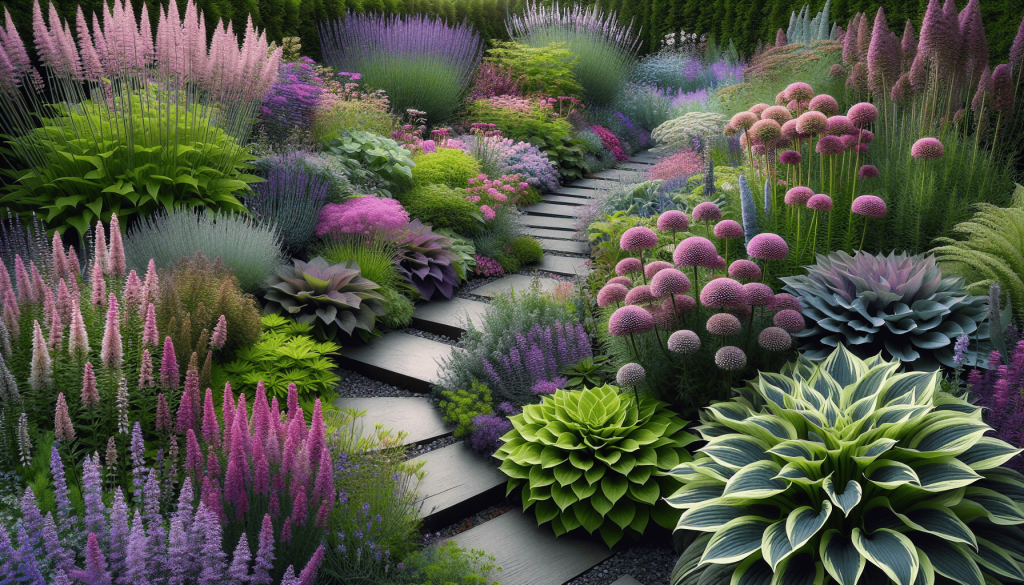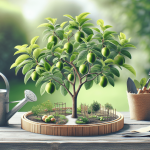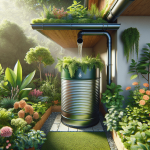This post may contain affiliate links. As an Amazon Associate, we may earn commissions from qualifying purchases.
How do you design a garden with low-maintenance perennials? If your dream includes a vibrant garden that doesn’t require a lot of fuss, you’re in the right place. Low-maintenance perennials can provide a beautiful, consistent display throughout the seasons without demanding constant attention. Let’s chat about how to get started on your own easy-care garden oasis.
Understanding Perennials and Their Appeal
Perennials are those reliable plants that keep coming back year after year. Unlike annuals, which need to be replanted each year, perennials establish roots and grow stronger over time. Not only do they save you from the annual planting hustle, but they also provide a stable structure to your garden.
Why Choose Perennials?
Perennials are the backbone of a garden. Their enduring nature means your garden has a consistent look through multiple seasons. Plus, many perennials are remarkably hardy, standing up to a variety of weather conditions and requiring minimal intervention. From the delightful daylilies to resilient coneflowers, there’s a perennial to suit every garden’s needs.
Key Characteristics of Low-Maintenance Perennials
You might be wondering what sets low-maintenance perennials apart. Generally, these plants are:
- Drought Tolerant – They can survive with minimal watering once established.
- Pest Resistant – They suffer fewer issues from common garden pests.
- Hardy – They can thrive in a variety of soil types and climatic conditions.
- Less Proning & Deadheading – They don’t require frequent pruning or deadheading to stay healthy and attractive.
By choosing plants with these attributes, you simplify your gardening tasks significantly.
Planning Your Low-Maintenance Perennial Garden
Before getting those green thumbs dirty, it’s crucial to lay down some groundwork. The more you plan, the less you’ll have to worry later.
Assess Your Garden Space
First things first, take a good look at your garden space. Assess factors like:
- Soil Quality: Knowing your soil type (clay, loamy, sandy) will help in selecting the right perennials.
- Sunlight Exposure: Make a note of areas that receive full sun, partial shade, or full shade throughout the day.
- Climate: Local climate conditions (rainfall, temperature ranges) play a significant role in plant selection.
- Existing Plants: Consider what plants are already thriving in your garden, as these can indicate what might work well.
Select the Right Plants for Your Needs
Armed with information about your garden, it’s time to choose your plants. Here’s a handy table to guide you through some excellent low-maintenance perennials based on different conditions:
| Condition | Plant Suggestions |
|---|---|
| Full Sun | Lavender, Russian Sage, Coneflower, Black-eyed Susan |
| Partial Shade | Hostas, Astilbe, Heuchera, Lamium |
| Full Shade | Ferns, Hellebore, Solomon’s Seal, Ligularia |
| Poor Soil | Sedum, Catmint, Daylilies, Yarrow |
| Drought Conditions | Agastache, Salvia, Blanket Flower, Penstemon |
Design Principles To Keep In Mind
When designing with low-maintenance perennials, a few principles can help create a cohesive and attractive garden:
- Layering: Use a variety of heights in plantings to create depth. Taller plants should be at the back, middle-sized in the middle, and short groundcovers at the front.
- Seasonal Interest: Choose plants that bloom at different times of the year to ensure continuous color and texture.
- Color Harmony: Pick a color scheme that suits your garden style – this could be monochromatic, complementary, or analogous.
- Repetition: Repeat certain plants or colors throughout your garden for a sense of unity.
Grouping Plants by Water Needs
Grouping plants with similar water needs is a crucial step in creating a low-maintenance garden. This technique, known as hydrozoning, ensures that each plant receives the appropriate amount of water without over or under-saturating any part of your garden. For instance, placing drought-tolerant plants like lavender and yarrow together can simplify your watering routine. Conversely, plants that prefer more moisture, such as hostas and astilbe, can be grouped to benefit from occasional deep watering.

Planting and Initial Setup
Congratulations, planning is now behind you! Next, comes the exciting part – preparing the soil and planting your perennials.
Preparing the Soil
Even low-maintenance perennials appreciate a good start. Proper soil preparation can set the stage for less care in the future:
- Soil Testing: Conduct a soil test to determine its pH and nutrient levels. This will inform whether you need to amend the soil.
- Amendments: Add organic matter like compost to improve soil structure, drainage, and fertility.
- Weed Control: Remove existing weeds to reduce competition for resources. A thick layer of mulch can suppress weed growth and retain soil moisture.
Planting Techniques
Timing and technique matter when planting perennials. Here’s a step-by-step approach to get it right:
- Timing: Plant your perennials in spring or fall when temperatures are moderate.
- Hole Preparation: Dig a hole twice as wide and as deep as the plant’s root ball.
- Positioning: Place the plant in the hole at the same depth it was in its pot, spreading out the roots gently.
- Backfilling: Fill the hole with soil, pressing down lightly to eliminate air pockets.
- Watering: Water thoroughly to help the plant settle and establish roots.
Mulching and Watering
Mulching and watering might sound like tasks for the faithful gardener but stick with me — they don’t have to be tedious.
Benefits of Mulching
Mulch is a gardener’s best friend for several reasons:
- Moisture Retention: Mulch reduces evaporation, keeping the soil moist longer.
- Weed Suppression: A thick layer of mulch stifles weed growth.
- Temperature Regulation: Mulch insulates roots against extreme temperature fluctuations.
- Soil Improvement: Organic mulch breaks down over time, enriching the soil.
Apply a 2-3 inch layer of organic mulch (like composted bark or leaf mold) around your plants, ensuring it doesn’t touch the stems to prevent rot.
Smart Watering
Even drought-tolerant plants need water to establish their roots. However, smart watering can minimize labor:
- Deep Watering: Water deeply but infrequently to encourage root growth.
- Early Morning or Late Evening: Watering in the cooler parts of the day reduces evaporation and disease risk.
- Drip Irrigation: Consider a drip irrigation system for efficient, targeted watering.

Pruning and Deadheading
Pruning and deadheading can seem intimidating but don’t worry, these tasks are simpler than you might think and can make a big difference in your garden’s appearance and health.
Pruning Basics
Pruning involves cutting back plants to promote healthy growth and improve appearance. Low-maintenance perennials usually require minimal pruning:
- Timing: Prune in late winter or early spring before new growth starts.
- Method: Remove dead, damaged, or diseased stems first. For most perennials, a simple cut back to ground level is sufficient.
Deadheading for Continuous Bloom
Deadheading is the removal of spent flowers, which can encourage a second bloom period:
- Frequency: Check for spent flowers weekly during blooming season.
- Technique: Use clean, sharp scissors or pruners to snip off spent blooms just above the next leaf bud.
Fertilization and Soil Care
Low-maintenance doesn’t mean no maintenance. A little effort in fertilization and soil care can ensure your perennials remain healthy.
Fertilization Tips
Too much fertilizer can be harmful. Here’s a balanced approach:
- Organic Options: Use compost or well-rotted manure in spring to enrich the soil.
- Slow-release Formulas: If using chemical fertilizers, opt for slow-release types to provide consistent nutrients over time.
- Application: Apply fertilize in early spring and mid-summer, following product instructions to avoid over-fertilization.
Soil Health
Healthy soil is the foundation of a thriving garden:
- pH Monitoring: Check soil pH every couple of years to maintain optimal levels for plant health.
- Organic Matter: Continually add organic matter to improve soil structure and fertility.
- Avoid Compaction: Keep foot traffic in garden beds to a minimum to avoid compacting the soil.
Pest and Disease Management
Low-maintenance perennials are typically resistant to pests and diseases, but it’s important to stay vigilant.
Natural Pest Control
Avoid harsh chemicals and go for eco-friendly methods:
- Companion Planting: Plant herbs like basil or lavender to repel pests.
- Beneficial Insects: Encourage predatory insects like ladybugs by planting nectar-rich flowers.
- Handpicking: Regularly check plants and handpick any pests you see.
Disease Prevention
Good gardening practices can prevent most diseases:
- Proper Spacing: Ensure sufficient space between plants for air circulation.
- Watering Technique: Water at the base, not the foliage, to minimize disease risk.
- Cleanliness: Dispose of any diseased plant material promptly.
Seasonal Care for Perennials
Even low-maintenance perennials require some seasonal care to keep them at their best year-round.
Spring Care
Spring is a busy time, as plants awaken:
- Soil Preparation: Add compost to beds and check for new weeds.
- Dividing Plants: Divide crowded perennials to rejuvenate them and encourage growth.
- Mulching: Refresh mulch to suppress weeds and retain moisture.
Summer Care
During summer, focus on water and pest management:
- Regular Watering: Ensure deep watering, especially during dry spells.
- Deadheading: Continue deadheading to prolong blooming.
- Monitoring Pests: Keep an eye out for pests and remove them promptly.
Fall Care
Fall is about preparing for winter:
- Pruning: Prune back dead foliage and remove any annuals.
- Dividing and Planting: Fall is a good time to plant new perennials and divide existing ones.
- Mulching: Apply a thick layer of mulch to protect roots from winter cold.
Winter Care
Winter care focuses on protection:
- Insulating Plants: Use mulch or straw to insulate tender perennials.
- Snow Removal: Gently remove heavy snow from branches to prevent breakage.
Long-term Maintenance Strategies
Consistency is key in maintaining a low-maintenance perennial garden. Keep a garden journal to track tasks and observe plant performance. Also, consider using automated systems for watering and lighting to further reduce your workload.
Garden Journal
A garden journal can be a valuable tool:
- Record Keeping: Note planting dates, bloom periods, and any issues that arise.
- Observations: Track weather conditions and how they impact your plants.
- Future Planning: Use your notes to plan future garden improvements.
Automation Tools
Automated systems can be a game-changer:
- Drip Irrigation: Automate watering to ensure consistent moisture levels.
- Timers: Use timers for watering and lighting systems to reduce manual labor.
Conclusion
Designing a garden with low-maintenance perennials is both an art and a science. By carefully selecting the right plants, preparing your garden space, and implementing smart maintenance practices, you can create a beautiful, thriving garden that demands minimal effort. Embrace the simplicity of perennials, and let nature do what it does best – grow, bloom, and bring joy to your outdoor space. Your garden can be a serene spot to relax without turning into a full-time job, and that’s something to relish.








